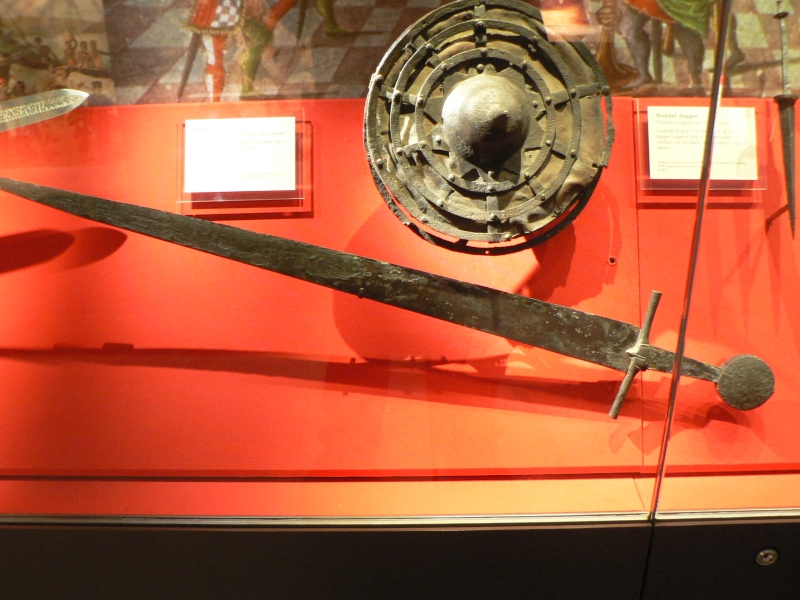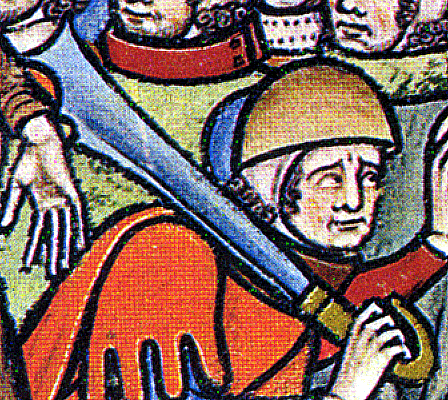| Author |
Message |
|
Tom Wolfe
Location: East Anglia, England Joined: 10 Aug 2015
Posts: 83
|
 Posted: Mon 26 Oct, 2015 9:55 am Post subject: Single-edged swords Posted: Mon 26 Oct, 2015 9:55 am Post subject: Single-edged swords |
 |
|
A rookie question, no doubt, but I'd be interested to know- I have seen European swords with a single blade edge dating from the Viking Age, and obviously there are plenty of sabre-type single edged swords from the 16th century and onwards. By the 18th century practically every European military sword is single edged.
So what about the in between time? I don't remember having ever seen single-edged sword blades from, say, 13th-15th centuries. Do they exist? Thanks!
Collector of original 16th-17th century European arms and armour. Would like to collect earlier, but budget doesn't allow- yet!
|
|
  |
 |
|
Gregory J. Liebau
Location: Dinuba, CA Joined: 27 Nov 2004
Posts: 669
|
 Posted: Mon 26 Oct, 2015 10:01 am Post subject: Posted: Mon 26 Oct, 2015 10:01 am Post subject: |
 |
|
Look up the terms falchion, storta, and kreigsmesser or alternatively langes messer. Should keep you busy for a while! 
|
|
  |
 |
|
Encho Yakovchev
|
|
  |
 |
Nathan Robinson
myArmoury Admin


|
 Posted: Mon 26 Oct, 2015 10:53 am Post subject: Posted: Mon 26 Oct, 2015 10:53 am Post subject: |
 |
|
As posted above, there are many, many styles of medieval single-edged swords. One might want to read our primer, Forms of European Edged Weaponry. As mentioned by the topic author, many of these styles are more popular in the 16th century onwards.
Additionally, there are swords that might appear at first glance to have two edges but are actually single-edged.
Eric McHugh made a reproduction based on one from Leeds and it can be seen in his topic. I'd guess many people saw the photo of the antique several times without realizing it has only one edge.

14th century, single edged, short sword from the Royal Armoury in Leeds
.:. Visit my Collection Gallery :: View my Reading List :: View my Wish List :: See Pages I Like :: Find me on Facebook .:.
|
|
    |
 |
|
Tom Wolfe
Location: East Anglia, England Joined: 10 Aug 2015
Posts: 83
|
 Posted: Tue 27 Oct, 2015 2:15 am Post subject: Posted: Tue 27 Oct, 2015 2:15 am Post subject: |
 |
|
Gregory, Encho, thank you for your responses. I am of course familiar with the falchion and storta, but I don't really regard them as "swords proper". The references to kreigsmesser and langes messer were very helpful though. The existence of swords like this which, to my eye, look very similar to a typical broadsword is very interesting and rather begs the question- why didn't they sharpen a cutting edge on both sides?
 Attachment: 14.51 KB Attachment: 14.51 KB

Collector of original 16th-17th century European arms and armour. Would like to collect earlier, but budget doesn't allow- yet!
|
|
  |
 |
|
Tom Wolfe
Location: East Anglia, England Joined: 10 Aug 2015
Posts: 83
|
 Posted: Tue 27 Oct, 2015 2:29 am Post subject: Posted: Tue 27 Oct, 2015 2:29 am Post subject: |
 |
|
| Nathan Robinson wrote: | As posted above, there are many, many styles of medieval single-edged swords. One might want to read our primer, Forms of European Edged Weaponry. As mentioned by the topic author, many of these styles are more popular in the 16th century onwards.
Additionally, there are swords that might appear at first glance to have two edges but are actually single-edged.
Eric McHugh made a reproduction based on one from Leeds and it can be seen in his topic. I'd guess many people saw the photo of the antique several times without realizing it has only one edge.

14th century, single edged, short sword from the Royal Armoury in Leeds |
Thanks Nathan- the point you made about single-bladed swords that at first sight look double-sided hits the nail on the head. The point that has prompted my enquiry is that I saw a sword recently, which I am considering buying. The sword is described as late 15th century. It has an S shaped guard and a large ball-shaped fluted pommel (please excuse lack of any more technical language). The blade, while appearing at first sight to be double-edged is in fact single-edged, and it is this that I found rather odd- hence my appeal for further information.
Thank you to all.
Collector of original 16th-17th century European arms and armour. Would like to collect earlier, but budget doesn't allow- yet!
|
|
  |
 |
|
Gregory J. Liebau
Location: Dinuba, CA Joined: 27 Nov 2004
Posts: 669
|
 Posted: Tue 27 Oct, 2015 3:10 am Post subject: Posted: Tue 27 Oct, 2015 3:10 am Post subject: |
 |
|
| Tom Wolfe wrote: | | Gregory, Encho, thank you for your responses. I am of course familiar with the falchion and storta, but I don't really regard them as "swords proper". |
What would you regard them as? They certainly aren't knives or daggers... Any reference book, museum or arms connoisseur would consider them to be among the most representative types of "single-edged swords" of the medieval period.
-Gregory
|
|
  |
 |
|
Tom Wolfe
Location: East Anglia, England Joined: 10 Aug 2015
Posts: 83
|
 Posted: Tue 27 Oct, 2015 3:15 am Post subject: Posted: Tue 27 Oct, 2015 3:15 am Post subject: |
 |
|
| Gregory J. Liebau wrote: | | Tom Wolfe wrote: | | Gregory, Encho, thank you for your responses. I am of course familiar with the falchion and storta, but I don't really regard them as "swords proper". |
What would you regard them as? They certainly aren't knives or daggers... Any reference book, museum or arms connoisseur would consider them to be among the most representative types of "single-edged swords" of the medieval period.
-Gregory |
I agree- I think it is my personal perception that is at fault and needs to be updated rather than the intrinsic character of the weapons themselves. I am still quite new to learning about mediaeval swords, and I still haven't entirely shed the simplistic view of mediaeval swords all being broadswords. I am learning though....
Collector of original 16th-17th century European arms and armour. Would like to collect earlier, but budget doesn't allow- yet!
|
|
  |
 |
Nathan Robinson
myArmoury Admin


|
 Posted: Tue 27 Oct, 2015 11:10 am Post subject: Posted: Tue 27 Oct, 2015 11:10 am Post subject: |
 |
|
| Tom Wolfe wrote: | | Gregory, Encho, thank you for your responses. I am of course familiar with the falchion and storta, but I don't really regard them as "swords proper". The references to kreigsmesser and langes messer were very helpful though. The existence of swords like this which, to my eye, look very similar to a typical broadsword is very interesting and rather begs the question- why didn't they sharpen a cutting edge on both sides? |
Falchions/storta/etc. are certainly sword. Messers, on the other hand, are really large knives (hence their names). They were considered as such by the guilds of makers of the time; the distinction was there in period and for most of us remains today. Construction methodology differs, too.
Regarding the question why not sharpen both edges, I am reminded of this topic: Single vs double edged swords
.:. Visit my Collection Gallery :: View my Reading List :: View my Wish List :: See Pages I Like :: Find me on Facebook .:.
|
|
    |
 |
|
Lance Morris
|
|
  |
 |
Nathan Robinson
myArmoury Admin


|
|
    |
 |
|
Timo Nieminen
|
 Posted: Tue 27 Oct, 2015 4:31 pm Post subject: Posted: Tue 27 Oct, 2015 4:31 pm Post subject: |
 |
|
| Tom Wolfe wrote: | | The existence of swords like this which, to my eye, look very similar to a typical broadsword is very interesting and rather begs the question- why didn't they sharpen a cutting edge on both sides? |
For the same blade width, thickness, and cross-sectional area along the length of the blade, a single-edged blade gives you a more acute edge angle (wedge cross-section vs diamond cross-section), and potentially better cutting (with the cost of a possibly more fragile edge). There are also blade construction types that are easier for single-edged blades. E.g., inserted-edge construction, and various laminated constructions. Differential quenching or tempering is also easier with single-edged blades.
Similar swords are seen from China, single-edged swords (i.e., dao) which look like double-edged swords (i.e., jian) in profile.
While it can be useful to have two edges, you usually only cut with one edge at a time, so single-edged is fine, too. Then there is the common compromise between the two, where the back edge is only partial (perhaps only 6" or so near the point, or it can be 1/3 or 1/2 of the blade).
"In addition to being efficient, all pole arms were quite nice to look at." - Cherney Berg, A hideous history of weapons, Collier 1963.
|
|
   |
 |
Craig Peters

|
 Posted: Tue 27 Oct, 2015 5:12 pm Post subject: Posted: Tue 27 Oct, 2015 5:12 pm Post subject: |
 |
|
The other reason why you don't sharpen all of the back edge on many single-edged swords is that a thicker edge (the "spine") of the sword, allows you to create a wedge-shaped blade. This point is implicit in Timo's comment, yet I felt it was worth making it more explicit.
Related to this topic, have you seen the so-called "Maciejowski chopper"? It probably was a single-edged sword, too:

|
|
  |
 |
|
|
You cannot post new topics in this forum
You cannot reply to topics in this forum
You cannot edit your posts in this forum
You cannot delete your posts in this forum
You cannot vote in polls in this forum
You cannot attach files in this forum
You can download files in this forum
|
All contents © Copyright 2003-2024 myArmoury.com — All rights reserved
Discussion forums powered by phpBB © The phpBB Group
Switch to the Basic Low-bandwidth Version of the forum
|

